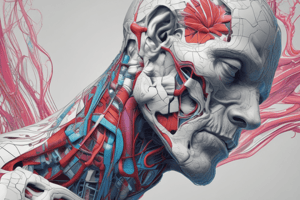Podcast
Questions and Answers
What is the level of organization that includes groups of similar cells that perform specific functions?
What is the level of organization that includes groups of similar cells that perform specific functions?
- Cellular level
- Tissue level (correct)
- Chemical level
- Organ level
What is the cavity that contains the brain and spinal cord?
What is the cavity that contains the brain and spinal cord?
- Ventral cavity
- Thoracic cavity
- Abdominopelvic cavity
- Dorsal cavity (correct)
What is the region that includes the head, neck, thorax, and abdomen?
What is the region that includes the head, neck, thorax, and abdomen?
- Axial region (correct)
- Lower limb
- Upper limb
- Appendicular region
What is the term for 'front' in directional terms?
What is the term for 'front' in directional terms?
What is the plane that divides the body into left and right halves?
What is the plane that divides the body into left and right halves?
In the anatomical position, what direction are the palms of the hands facing?
In the anatomical position, what direction are the palms of the hands facing?
Flashcards are hidden until you start studying
Study Notes
Organization of the Body
- The human body is organized into several levels of complexity:
- Chemical level: atoms, molecules, and compounds
- Cellular level: cells, the basic structural and functional units of the body
- Tissue level: groups of similar cells that perform specific functions
- Organ level: structures composed of two or more types of tissues that perform specific functions
- Organ system level: groups of organs that work together to perform specific functions
- Organismal level: the entire human body
Body Cavities
- Dorsal cavity: contains the brain and spinal cord
- Ventral cavity: contains the thoracic and abdominopelvic cavities
- Thoracic cavity: contains the lungs, heart, and major blood vessels
- Abdominopelvic cavity: contains the abdominal and pelvic organs
Body Regions
- Axial region: includes the head, neck, thorax, and abdomen
- Appendicular region: includes the upper and lower limbs
- Upper limb: consists of the scapula, arm, forearm, wrist, and hand
- Lower limb: consists of the hip, thigh, leg, ankle, and foot
Directional Terms
- Anterior: front
- Posterior: back
- Superior: above
- Inferior: below
- Medial: towards the midline
- Lateral: away from the midline
- Proximal: near the point of attachment
- Distal: far from the point of attachment
Body Planes
- Sagittal plane: divides the body into left and right halves
- Frontal plane: divides the body into anterior and posterior halves
- Transverse plane: divides the body into superior and inferior halves
Anatomical Position
- The body is standing upright, with feet shoulder-width apart and directed forward
- Arms are at the sides, with palms facing forward
- The face is directed forward, with eyes looking straight ahead
Organization of the Body
- The human body is organized into six levels of complexity: chemical, cellular, tissue, organ, organ system, and organismal.
- Each level builds upon the previous one to form a hierarchical structure.
Body Cavities
- The dorsal cavity contains the brain and spinal cord.
- The ventral cavity is divided into thoracic and abdominopelvic cavities.
- The thoracic cavity contains the lungs, heart, and major blood vessels.
- The abdominopelvic cavity contains the abdominal and pelvic organs.
Body Regions
- The axial region includes the head, neck, thorax, and abdomen.
- The appendicular region includes the upper and lower limbs.
- The upper limb consists of the scapula, arm, forearm, wrist, and hand.
- The lower limb consists of the hip, thigh, leg, ankle, and foot.
Directional Terms
- Anterior refers to the front of the body.
- Posterior refers to the back of the body.
- Superior refers to a location above another point.
- Inferior refers to a location below another point.
- Medial refers to a location towards the midline of the body.
- Lateral refers to a location away from the midline of the body.
- Proximal refers to a location near the point of attachment.
- Distal refers to a location far from the point of attachment.
Body Planes
- The sagittal plane divides the body into left and right halves.
- The frontal plane divides the body into anterior and posterior halves.
- The transverse plane divides the body into superior and inferior halves.
Anatomical Position
- In the anatomical position, the body stands upright with feet shoulder-width apart and directed forward.
- The arms are at the sides, with palms facing forward.
- The face is directed forward, with eyes looking straight ahead.
Studying That Suits You
Use AI to generate personalized quizzes and flashcards to suit your learning preferences.





